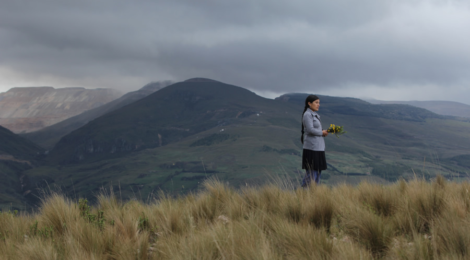
Documenting Extraction in LA HIJA DE LA LAGUNA (Ernesto Cabellos, 2015)
Today, Mediático presents an entry by regular contributor Carolyn Fornoff, Assistant Professor of Spanish at Lycoming College. She has research interests in twentieth-century Latin American literature and film with a focus on Central America and Mexico, the environmental humanities and the politics of nature in culture, feminist and queer theories, and subjectivity and affect in contemporary culture. She has previously written for Mediatico on the Guatemalan film Ixcanul. Fornoff has a website here and you can follow her on Twitter at @c4noff.
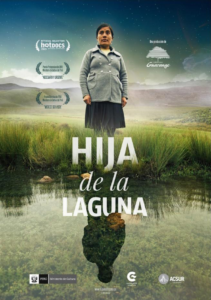
Documenting Extraction in La hija de la laguna (Ernesto Cabellos, 2015)
By Carolyn Fornoff
Over the past ten years, documentary filmmaking in Latin America has experienced a renaissance. The reasons behind this boom, as María Guadelupe Arenillas and Michael Lazzara note in their introduction to Latin American Documentary Film in the New Millennium, are multiple. The necessary technology has become cheaper and more accessible. In comparison with other genres, documentaries are relatively quick to make and require smaller up-front investment, which is generally recouped on the international festival circuit. Festival demand for Latin American documentaries is also up, giving documentarians a place to showcase their work and make the case for wider distribution.
A key gatekeeper for international distribution is, of course, Netflix. With 89 million paying members worldwide as of 2017, films streamed on Netflix have access to massive global audiences. Netflix essentially regulates what we watch, through which films they choose to license. Data plays a big role in this selection process. Through analytics, Netflix uses a demand predictive model to determine which titles will have the best content efficiency, that is, the best value-to-cost ratio. To predict demand for a film, they look at data points like box office performance, critical reception, and awards (reinforcing the importance of performance on the festival circuit). [i] This is weighed against how much licensing will cost.
With rising global interest in topics like climate change and environmental degradation, Netflix has steadily increased content geared toward environmentally minded viewers. Several of the Latin American documentaries available for streaming in the US are situated at the intersection of environment and activism, including When Two Worlds Collide (Heidi Brandenburg and Mathew Orzel 2016) and México Pelágico (Jerónimo Prieto 2014). What interests me today is the most recent addition to this category, La hija de la laguna (Daughter of the Lake, 2015), directed by Ernesto Cabellos Damián, and made available to Netflix viewers worldwide at the beginning of May 2017.
La hija de la laguna responds to the Andean gold rush, tracking its impact on the environment and indigenous communities. It shows how proliferating, poorly regulated mining operations have adversely affected rural communities’ access to water, disrupted the ecosystem, and altered soil conditions, making sustainable farming increasingly untenable. Many factors contributed to this crisis, but the dramatic spike in world gold prices between 2001 and 2012 definitively drove the escalation in mining. The New Yorker reported that according to researcher Miguel Santillana, as of 2015, there were around 400,000 informal gold miners working in Peru. Minerals are the country’s biggest export; with black-market gold accounting for its largest illegal export—beating out cocaine.

In his fourth feature-length documentary, director Ernesto Cabellos tells the story of Perú’s extractivist economy chiefly through the eyes of Nélida Ayay Chilón. She is the titular daughter whose neighboring lake is threatened by the discovery of gold deposits. The documentary opens with Nélida visiting the lake, and asking where its duende, or spirit, will go if the Yanacocha mining company drains the lake to extract the minerals beneath. This opening sequence foregrounds Nélida’s point of view, and didactically introduces Western viewers to indigenous worldviews, which attribute personhood (or souls) to all living beings, both human and nonhuman.
The camera quickly establishes Nélida as the film’s ethical arbiter. Fifteen minutes in, we observe her walk up a hill and survey the landscape below. The camera slowly pans from lush green hills to red-gray knolls sucked dry by quarrying. From this bird’s eye view, the camera dwells on the contrast between the Edenic Andean countryside and the adjacent extractivist landscape, distorted and lifeless. Tight reaction shots of Nélida’s face as she gazes down at the site configure her as witness to this transmutation. Close-ups foreground her face as the privileged site of communicative pathos. These protracted shots of the face bring to mind Levinas’s argument that the face-to-face encounter is the basis of ethics. By coming face-to-face with an other, Levinas proposed, they are radically exposed to us. In encountering the other’s face, we see their vulnerability, and are called to take responsibility.
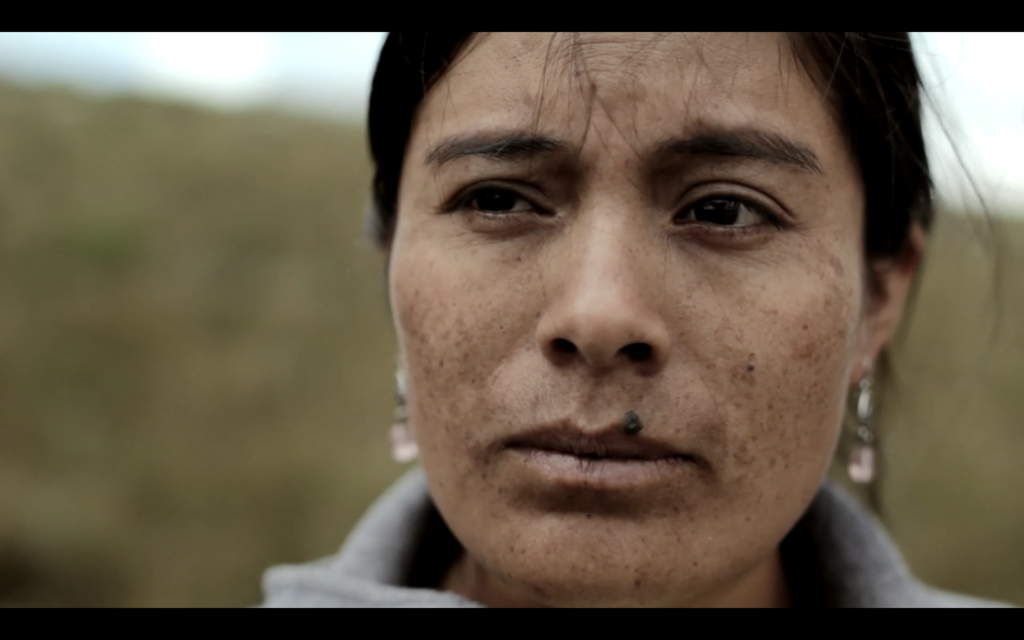
Tight reaction shots of Nélida’s non-verbal sorrow generates heightened visual pathos.
This representation of Nélida as the face that sparks ethical recognition is buttressed by her status as exemplary victim, a trope common to the activist genre. Nélida does everything possible to fight for her community in Cajamarca. She leaves her home to study law in Lima, in order to better advocate for water rights. She protests. She educates illiterate neighbors about their rights. In other words, she is victimized, but not a passive victim. This framing constructs her as a “legitimate” or “ideal victim” of the extractivist economy, in an analogous sense to how it has been identified by scholarship on victims of rape and police brutality. One of the problems with this construct, as Sandra Walkate points out in Imagining the Victim of Crime, is that some people are seen as “deserving victims, that is, [they] acquire the label ‘victim’ very readily and easily, [while] other people [are] viewed as undeserving victims who may never be labeled as victims” at all (28).
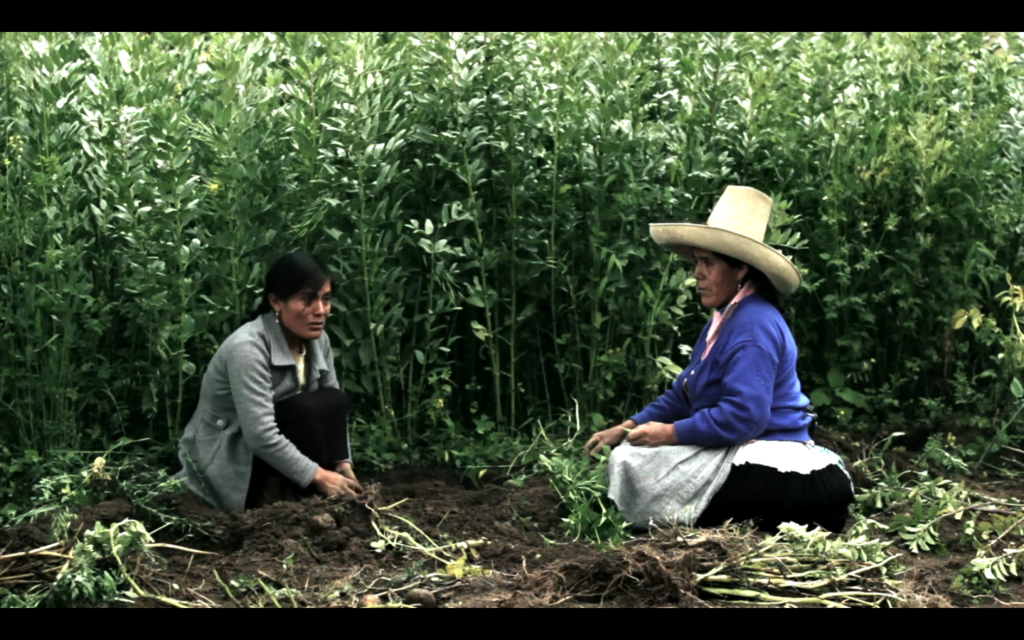
A beautifully rendered scene of Nélida’s return home underscores the difficulty of her decision to leave the countryside to study law in Lima. Set against a verdant maize backdrop, Nélida sifts her hands through the dirt and tells her mother about feeling the painful absence of nonhuman life in the concrete city.
A problem that emerges from this narrative privileging of the “ideal victim” is that many of those caught in the middle of this dialectic—who are not well-intentioned indigenous farmers, nor greedy tycoons—are rendered invisible. Specifically, as Ignacio Sánchez Prado pointed out in a conversation at the most recent Society for Cinema and Media Studies, laborers themselves are curiously absent from environmentalist documentaries. That is, in their desire to foreground “pure” heroines who exist outside of capital, documentaries seem to privilege the peasantry over the proletariat. A downside to this narrative omission is that audiences are left with an incomplete understanding of why people participate in these practices in the first place. La hija de la laguna, however, smartly navigates this stumbling block. Although indigenous farmers are the narrative focus, the documentary also profiles an all-women mining collective in Bolivia. Following the collective into the depths of a mine in Oruro, the women sit together and describe their relationship with the mountain’s spirit, sexism, and the imperative to work in order to provide food for their children.
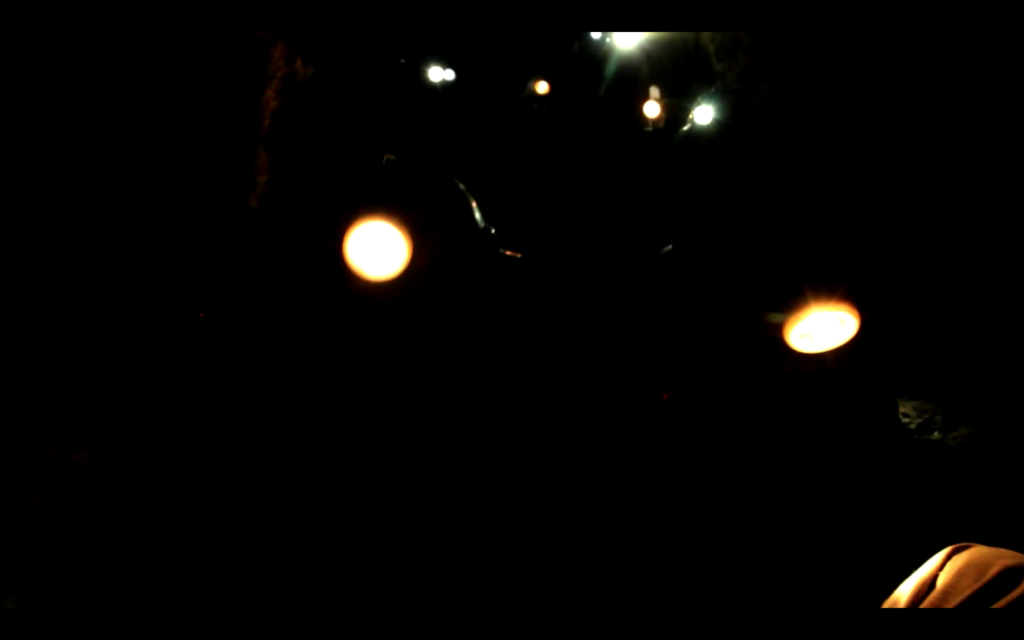
The camera tracks the women’s bobbing headlights down into the mine’s depths.
Explicitly connecting the labor of extraction with consumption, the documentary moves from the mining collective to Dutch jewelry designer Bibi van der Velden’s shop. Close, prolonged shots of her designer pieces are accompanied by her voice-over explanation that gold “has something magical, it has something like a promise, it promises beautiful moments.” Her observations illustrate how the discourse around gold associates it with both aesthetic beauty and the promise of a good life: one of leisure and monetary security. Jewelry embodies this promise; the fact that the labor behind its production is obscured merely reinforces the film’s message that to enjoy the promise of “beautiful moments” is to willingly turn a blind eye to its means of production.
Bibi’s scenes also reveal the persistent discursive collapse of nature with non-white bodies. She explains that she likes to use “a lot of unconventional materials straight from nature” in her designs. This is followed by a perturbing sequence in which a series of models walk the runway, modeling her designs. The models, all of who are black women, are topless and stylized with a “primitive” African aesthetic in mind: feather headpieces, ivory trunks, and Tarzan-esque tunics.
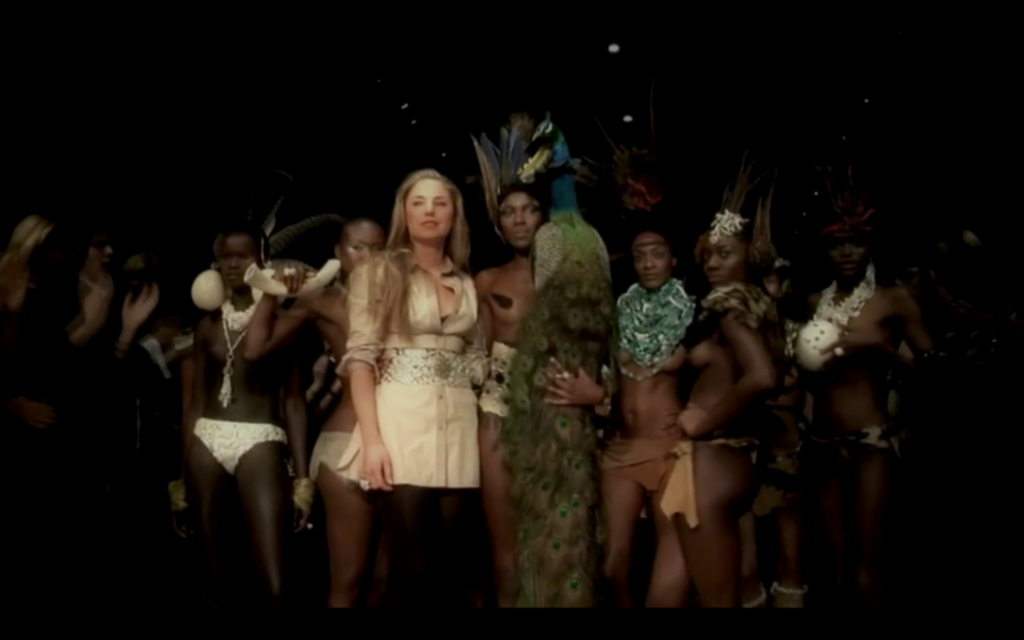
The clothed white designer is front and central, while her black models are stylized in a fashion that stresses the “naturalness” of both their naked bodies and the jewelry.
This sequence dramatizes the white fantasy of “the primitive” and its concomitant racist equation of raw materials with non-white bodies. This explicit signposting of the pernicious collapse of “nature” with blackness serves as a lingering warning to the viewer throughout the rest of the film. On the one hand, the film makes the case that a move toward caring for nature is a move toward indigeneity, since the nonhuman has long been racialized. Yet in crafting a space that stresses the intersection between indigeneity and environment, the documentary navigates a difficult balancing act between celebrating these worldviews, while resisting their romanticization by white audiences.
The arc of Bibi’s redemption is clear. The next time she appears on screen, it is no longer smiling surrounded by black women modeling her wares, but on a trip to the Madre de Dios region, which has been called “ground zero of Peru’s gold rush.” She is there to learn more about how the gold she sources is mined. What she finds is disconcerting: the region has been turned upside down by the influx of small-scale miners, plagued by prostitution and alcoholism. Unlike some of the film’s savvier moments, this segment does not profile the laborers, but instead deploys them as props in the service of Bibi’s political awakening. Foregrounding Bibi as she gazes down at men working in an unregulated gold mine, the camera lingers on her as she uncomfortably fidgets, until finally turning her back on the men below.
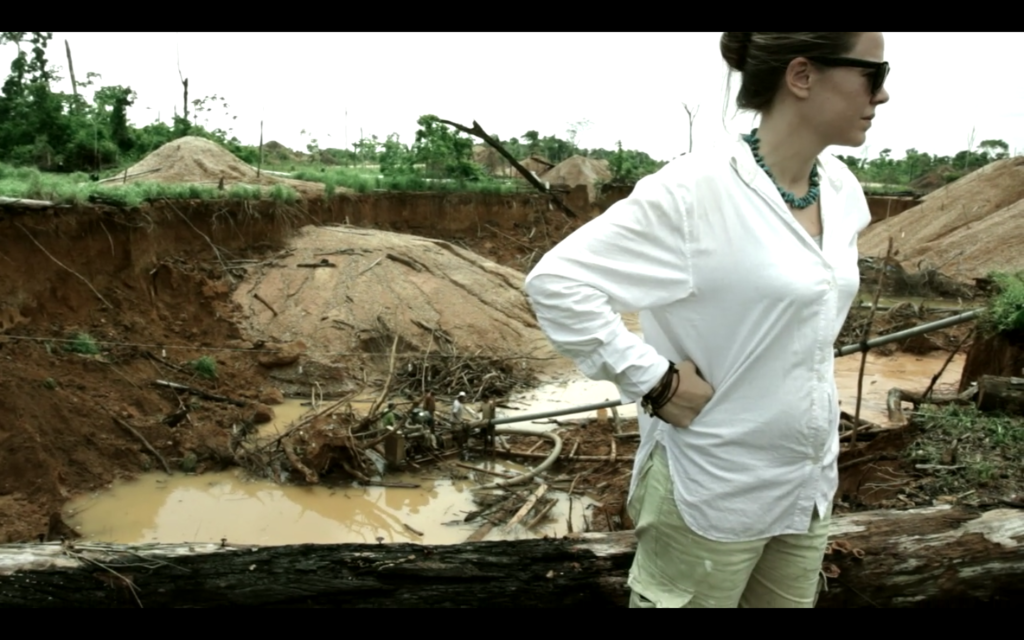
Bibi turns her back on the laborers below in horrified shame. Unlike them, she is foregrounded and in focus. It is her journey toward realizing her complicity that is the focal point.
It is a well-executed spectacle of white guilt. The viewer of the documentary—particularly the Netflix viewer, who is likely non-Peruvian—is pushed to identify with Bibi and confront their own complicity with environmental degradation and global structures of inequity. Or—perhaps the viewer feels protected, anonymous on the other side of the screen, in contrast to Bibi’s exposed ignorance. Regardless, the spectacle of white guilt is resolved quickly. Now awakened, Bibi details the labor that goes into 5 grams of gold: 6 people, working nonstop for 24 hours. Invoking a rhetoric of shame, she concludes, “we all have blood hanging on our fingers, and wrists, and necks.”
The scene of Bibi’s awakening to her participation in the economy of extractivism brings up an interesting question: do we have to see in order to believe? Bibi only recognizes her complicity once she has been brought face-to-face with the conditions of mining in Peru. The focus on seeing, of course, also serves as an argument in favor of the documentary’s very existence. Documentary, derived from the Latin documentum, promises both “lesson” and “proof”: to teach by making visible. La hija de la laguna aims to raise awareness to the devastating effects of global gold demand on communities in Peru, yet it inevitably harnesses Netflix viewers’ interest through the lure of journeying to a faraway land with people who are unlike us, without any commitment of face-to-face interaction. This prompts a perennial question associated with ecocinema, whether it can really accomplish its goal of changing viewers’ behavior. Or, is it inevitable that after watching, we prefer to turn away, like Bibi?
[i] Content available to stream very much varies by region. According to Netflix, the reasons for regional variation include localized tastes as well as legal questions of distribution rights.







Gracias, Catherine, por este artículo, es muy útil. Me gusta su tono público, he podido usarlo en clase.
M. Saltzman